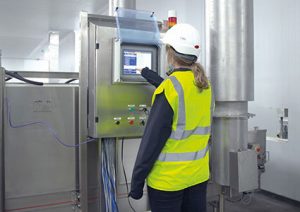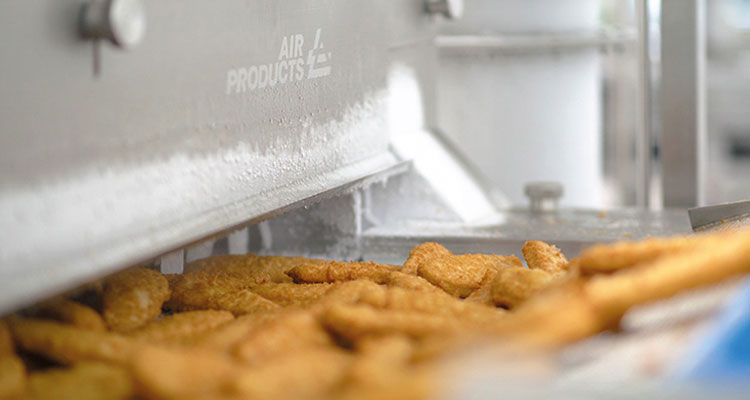Essential insights A case for using digital technology and data to drive efficiency. By Jon Trembley
The growing need for increased productivity, streamlining operations and the adoption of smart technology real-time data continues to see an upward trend. Having greater insight into the efficiency of a production line has never been more important. Businesses across the food sector need to not only reduce costs, extend shelf life and prevent product waste, but also achieve competitive advantage in an increasingly challenging economic climate.
We have witnessed that digital innovation and adopting a data-driven approach can help. The insight and knowledge that data capture and analysis can offer, if applied correctly, can directly impact a company’s productivity.
The UK food and drink sector is the UK’s largest manufacturing sector, worth £30bn, according to the Food and Drink Federation. In order for the market to continue to grow, there has to be sufficient investment in digital technology to build momentum.
Driving efficiency in the market

We appreciate the benefit that bringing data analysis into a business can bring to operational efficiency, and Icelandic Seafood International (ISI) is one example of a business using digital to drive efficiencies on the production line.
Working with ISI, we installed Air Products Smart Technology (APST) onto its cryogenic freezers, resulting in an immediate improvement to both the efficiency and productivity of production lines, and liquid nitrogen savings.
As a supplier of North Atlantic seafood, ISI required a system that could act in response to growing product demand, with items ramped up, or scaled down, dependent on customer requirements. It was also an opportunity to improve the efficiency of its freezing capabilities and switch to more advanced technologies. Having the option of adding data management into its operating system meant that business decisions could be supported by real-time information on product efficiency.
New technologies, such as APST, use diagnostic sensors and wireless communications technology to monitor and control freezing operations. The smart technology tracks key process parameters and advises on how to improve processes based on advanced analytics. Having a competitive edge and the added insight of knowing when and how a product’s chilling or freezing processes needed to be modified, is critical to business success.
Data as the driver
Digital technology really can play a central role in optimizing cryogenic freezer use, improving efficiency, productivity and sustainability, and giving customers better control of liquid nitrogen usage – all helping with competitive advantage. This was particularly true for ISI, which has been able to identify and resolve issues with how its product lines are run on a day-to-day basis.
By installing APST onto its cryogenic freezers, ISI has seen an immediate improvement in both the efficiency and productivity of its production lines. Monitoring of the infeed belt area of the freezer warns the customer if the product loading is poor. This, in turn, allows for alterations to the product feed which makes the freezing process more efficient.
ISI saw a noticeable improvement in liquid nitrogen usage, which had a direct impact on its operational cost, meaning that processes can be made more agile and adaptable than before.
Training and future-proofing
Of course, data capture and analysis is only effective if those operating production lines understand how to interpret and use the data to facilitate change. This is why it’s critical to provide training alongside the installation of new technologies. For example, we create and save recipes onto the human-machine interface control panel on the freezer, which we can then monitor through the APST system. This then avoids the need to manually change temperatures every time a new product is loaded. The impact? Less opportunity for manual error, and greater efficiency and quality of freeze.
New technologies also offer advantages in terms of knowledge retention at points of staff change. ISI’s new APST system, for example, is able to hold historical and real-time data, giving food producers greater reassurance that they’re not losing knowledge each time an operator leaves and allowing them to continue production without interruption.
Looking ahead to the future of data
Ultimately, we want to support food producers in creating the most streamlined manufacturing process possible, especially during periods of uncertainty.
We recognize that the future of the food sector will be driven by data. It has much to benefit from the transparency and insight greater data capture and analysis can offer. New technologies can be applied across a wide range of businesses throughout the food sector, which means that more and more manufacturers can access digital technology and data to impact how the business operates.
More than ever food manufacturers need greater control over their food processes to cater to the changing needs of the market. Using data and introducing technology will bolster resilience and ensure manufacturers are ready for future challenges.
For a list of the sources used in this article, please contact the editor.
Jon Trembley is Technology Manager for Cryogenic Applications at Air Products, a world-leading industrial gases company in operation for over 80 years focused on serving energy, environmental, and emerging markets. The company has two growth pillars driven by sustainability. Air Products’ base business provides essential industrial gases, related equipment and applications expertise to customers in dozens of industries, including refining, chemicals, metals, electronics, manufacturing, and food.
